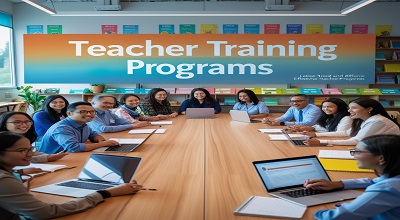Bilingual Teacher Training
Bilingual Teacher Training: In an increasingly globalized world, bilingual education has become a cornerstone of inclusive and equitable learning. As classrooms become more linguistically diverse, the demand for qualified bilingual educators has surged. This article delves into the latest developments in bilingual teacher training programs, highlighting innovative models, effective strategies, and real-world examples that are shaping the future of bilingual education.
The Importance of Bilingual Education
Bilingual education offers numerous benefits, including cognitive advantages, enhanced cultural awareness, and improved academic performance. Research indicates that bilingual individuals often exhibit better problem-solving skills, multitasking abilities, and a deeper understanding of diverse cultures. These advantages underscore the necessity of preparing educators who can effectively teach in bilingual settings.
Evolution of Bilingual Teacher Training
Traditional Approaches
Historically, bilingual teacher training programs focused on language proficiency and cultural competence. While these elements remain essential, there has been a shift towards incorporating comprehensive pedagogical strategies that address the unique needs of bilingual learners.
Contemporary Models
Modern bilingual teacher training programs emphasize:
- Content and Language Integrated Learning (CLIL): Teaching academic subjects through a second language to enhance both content knowledge and language skills.
- Dual Language Immersion (DLI): Programs where students are taught literacy and content in two languages, promoting bilingualism and biliteracy.
- Transitional Bilingual Education (TBE): Phasing out native language instruction as students’ proficiency in the second language increases.
- Maintenance Bilingual Education: Preserving students’ native language while they acquire proficiency in a second language.
These models are designed to create inclusive learning environments that support linguistic diversity.
Key Components of Effective Bilingual Teacher Training
1. Language Proficiency
Teachers must demonstrate high proficiency in both the target and native languages. Programs often include language assessments and advanced coursework to ensure educators can effectively communicate and teach in both languages.
2. Cultural Competence
Understanding and respecting cultural differences is crucial. Training programs incorporate cultural studies and experiential learning to prepare teachers to navigate and celebrate cultural diversity in the classroom.
3. Pedagogical Strategies
Effective bilingual educators employ diverse teaching methods, including:
- Scaffolding: Providing temporary support to students as they develop new skills.
- Differentiated Instruction: Tailoring teaching methods to accommodate diverse learning styles and abilities.
- Collaborative Learning: Encouraging students to work together, fostering language development through peer interaction.
4. Assessment Techniques
Implementing formative and summative assessments that consider language proficiency and content knowledge is vital. Programs train teachers to design and utilize assessments that are fair and reflective of bilingual learners’ abilities.
Notable Bilingual Teacher Training Programs
University of Texas at San Antonio (UTSA)
UTSA’s Signature Teacher Residency Model addresses the critical shortage of bilingual educators by supporting paraprofessionals in becoming certified bilingual teachers. The program offers financial support, academic guidance, and practical classroom experience, aiming to transform the lives of local paraprofessionals and enhance the learning experience for bilingual students.
UCLA Center X
The Bilingual Authorization Summer Intensive at UCLA provides K-12 educators in California with the opportunity to earn a Bilingual Authorization in Mandarin, French, or Spanish. This intensive program includes graduate-level courses, classroom observations, and a teaching practicum, enabling in-service teachers to complete the requirements over the summer.
Rowan University
Rowan University’s bilingual certification program prepares educators for real-world classrooms with multilingual students. Coursework covers second language acquisition, instructional strategies for bilingual classrooms, integrating content and language learning, and using technology to support multilingual learners.
Challenges in Bilingual Teacher Training
Despite the advancements, several challenges persist:
- Resource Constraints: Limited funding and resources can hinder the development and implementation of comprehensive training programs.
- Recruitment and Retention: Attracting and retaining qualified bilingual educators remains a significant challenge.
- Curriculum Development: Designing curricula that effectively integrate language and content instruction requires ongoing research and adaptation.
Future Directions
The future of bilingual teacher training lies in:
- Technology Integration: Utilizing digital tools and platforms to enhance language instruction and provide access to diverse resources.
- Community Engagement: Involving families and communities in the educational process to support bilingual learners.
- Continuous Professional Development: Offering ongoing training opportunities to ensure educators remain informed about best practices and emerging trends.
Conclusion
Bilingual teacher training programs are pivotal in fostering inclusive and effective learning environments. By equipping educators with the necessary skills and knowledge, these programs contribute to the academic success of bilingual students and the enrichment of the educational experience for all.
Frequently Asked Questions (FAQs)
1. What is the difference between Dual Language Immersion and Transitional Bilingual Education?
Dual Language Immersion programs aim to develop bilingualism and biliteracy by providing instruction in two languages throughout a student’s education. In contrast, Transitional Bilingual Education programs use the student’s native language to support English language development, gradually transitioning to English-only instruction.
2. How can paraprofessionals become bilingual educators?
Programs like UTSA’s Signature Teacher Residency Model offer pathways for paraprofessionals to earn teaching credentials. These programs provide financial support, academic guidance.
Free Here: Z Legends 3 APK
